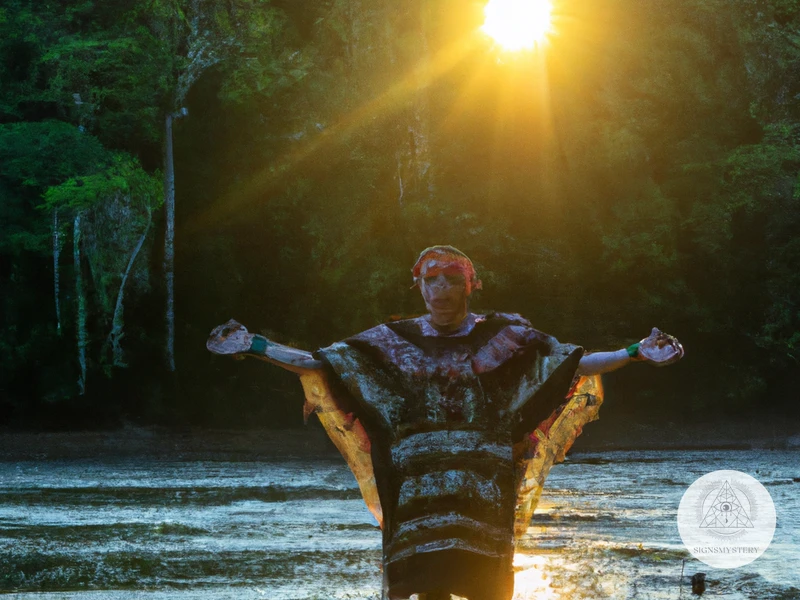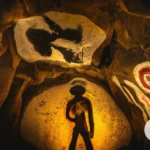For centuries, the spiritual practices of South American Shamanism have been a fascinating subject to many. Shamanism is a belief system that dates back to prehistoric times and has evolved to become a significant aspect of South American culture. This article aims to trace the history of South American Shamanism – from its origins to its contemporary practice. By exploring the roles, beliefs, and practices of ancient and modern shamanism, we can gain a deeper understanding of the evolution of this spiritual practice and its ongoing significance in the 21st century. So, let’s embark on a journey to understand the course of South American Shamanism.
Origins of South American Shamanism

The Origins of South American Shamanism date back to ancient times, where indigenous cultures recognized the spiritual power found in nature and sought to tap into it for healing and guidance. Shamanism played a central role in these cultures, with individuals known as shamans acting as intermediaries between the spiritual and physical worlds. Shamans used a combination of practices, including the use of medicinal plants, music, and ritual ceremonies to connect with the divine and provide healing for their communities. Early South American shamanism incorporated beliefs in the sacredness of both plants and animals, as well as the elements, with Andean and Amazonian shamanism developing unique practices based on their respective environments.
The Role of Shamanism in Ancient South American Culture
The role of shamanism in ancient South American culture was vital to the community. Shamans were respected and revered for their ability to heal, communicate with spirits, and interpret dreams. They served as a bridge between the physical and spiritual worlds and provided guidance and support to their people.
Examples of the role of shamanism in ancient South American culture:
- Shamans were responsible for interpreting dreams and communicating with ancestors to provide guidance to the community.
- Shamans conducted sacred ceremonies to honor nature, ancestors, and spirits. They also performed healing rituals and were believed to possess the ability to cure illness.
- The use of sacred plant medicines in shamanic practices was believed to provide a deeper connection to the spiritual world and to facilitate healing.
- Shamans were often called upon to mediate conflicts and maintain social harmony within the community.
The shaman was considered a teacher and guide, imparting wisdom and knowledge to the younger generations. The people of ancient South America believed in the interconnectedness of all things, and the shaman served as a conduit for this understanding.
Despite the many changes that South American culture has undergone over the centuries, shamanism remains an important part of the culture. The shaman continues to play a vital role in providing spiritual guidance and healing to those who seek it.
The Practices and Beliefs of Early Shamanism in South America
The practices and beliefs of early South American shamanism were heavily influenced by the spiritual connection with nature. Shamans believed that everything in nature, including animals, plants, and rocks, had a spirit or essence known as mana. They believed that the earth was a living entity that required a harmonious relationship with humans. Shamans derived their power from communicating with the spirits of nature and were responsible for maintaining balance and harmony in their communities.
Early South American shamanism involved the use of music, dance, and ritual to enter altered states of consciousness and communicate with the spirit world. Shamans often used psychoactive plants such as Ayahuasca or San Pedro cactus to facilitate these experiences. In addition to communication with nature spirits, early shamanism also involved the practice of soul retrieval, the process of bringing back parts of an individual’s soul that had been lost due to trauma or negative experiences.
Shamans were highly respected members of their communities who were consulted by community members for advice and healing. They performed important spiritual services such as divination, forecasting the future, and healing physical and emotional ailments. Early South American shamanism was a communal practice that involved the entire community in the shamanic journey, with the shaman acting as a guide in the process.
Early South American shamanism was deeply rooted in the belief in the interconnectedness of all living beings, including the natural world. It involved the use of sacred plants, music, and ritual to access the spirit world, restore balance and harmony, provide healing and guidance, and connect with the divine. To understand South American shamanism requires a deeper dive into the unique differences between Andean and Amazonian shamanism and the role that colonization and Catholicism played in its early development.
The Arrival of Europeans and the Impact on South American Shamanism
The arrival of Europeans in South America had a significant impact on the practice of shamanism in the continent. The influence of Catholicism and colonization disrupted traditional shamanic practices and beliefs, leading to the adaptation and transformation of shamanism in South America. European explorers introduced new technologies, religions, and diseases that had a lasting impact on the native populations, their culture, and spirituality. The arrival of missionaries also brought a new religion that conflicted with the native beliefs and practices. Some shamanic traditions and practices were able to adapt and incorporate certain elements of Catholicism, while others resisted, leading to the loss of many traditional practices. The impact of colonization and globalization on South American shamanism is complex and multifaceted, and continues to shape the practice and beliefs of modern shamanism in the region.
How Europeans Transformed Shamanic Practices in South America
The European arrival in South America had a significant impact on the traditional shamanic practices of the continent. With the arrival of European settlers, shamanism in South America began to merge with Catholicism. This resulted in the emergence of new hybrid practices that retained elements of both shamanism and Catholicism. The most notable example of this hybridization is the use of saints as spiritual entities in a way that is similar to animal spirits in traditional shamanism.
Additionally, the introduction of new technologies and materials from Europe, such as metal tools and guns, impacted the shamanic practices of South America. Many shamans began to incorporate these new items into their practices, creating new rituals and beliefs around them.
The arrival of Europeans also meant the introduction of new diseases to South America. As a result, many traditional shamanic practices such as healing ceremonies were modified to incorporate European medical practices.
This cultural exchange was not always peaceful, however. European colonizers often viewed traditional shamanic practices as primitive and a threat to their authority. Consequently, many indigenous people were persecuted and their practices were suppressed. Despite this, shamanic practices persisted, and many indigenous communities resisted the efforts to eradicate their cultural practices.
The arrival of Europeans in South America had a significant impact on traditional shamanic practices. The introduction of new technologies, materials, and diseases shaped the evolution of shamanism in the region. However, despite the efforts of European colonizers to suppress these practices, shamanism remains an important cultural tradition in South America today.
The Conflict and Struggle for Preservation of South American Shamanism
The arrival of Europeans in South America brought not only disease and exploitation but also a significant impact to the practice of shamanism. European colonization brought Catholicism, which viewed indigenous spiritual beliefs as heretical and pagan. This view led to the practice of shamanism being persecuted and driven underground. Many shamanic practices were lost during this time, and only a few were able to survive.
The struggle for the preservation of South American shamanism continued throughout the 20th century as globalization and modernization threatened to erase these ancient practices. Many indigenous communities fought to preserve their spiritual practices and protect their traditional ecological knowledge from outside influence. One example was the development of community-based shamanism, which emphasized the spiritual connection between community members and sought to adapt shamanic traditions to changing contexts.
The use of entheogenic plants like ayahuasca also played a significant role in the preservation of South American shamanism. These plants were considered sacred by indigenous communities, and their use in shamanic practices was seen as an important form of spiritual and cultural expression. Today, ayahuasca and other plant medicines are gaining popularity in Western countries and are contributing to the revitalization of shamanic practices in South America.
It is worth noting that the conflict and struggle for preservation of South American shamanism are ongoing, and many challenges remain. The loss of traditional ecological knowledge and the commodification of spiritual practices are just a few examples of the threats that modernization and globalization pose to this ancient tradition.
The preservation of South American shamanism is crucial not only for the indigenous communities that practice it but also for humanity as a whole. The spiritual practices of these communities are intimately connected to their relationship with the natural world and contain valuable insights into how we can better live in harmony with our environment. As such, it is essential that these practices be respected and protected for generations to come.
Entheogenic plants like ayahuasca have played a significant role in the preservation of South American shamanism.
The Contemporary Practice of South American Shamanism
The contemporary practice of South American shamanism is a blend of traditional beliefs and modern influences. Globalization has impacted the practice of shamanism, with many people from all over the world coming to South America to learn from indigenous shamans. Ayahuasca has gained popularity as a plant medicine used in shamanic practices and has been found to have therapeutic benefits, leading to an increase in its use. Contemporary shamanic healers in South America continue to work with various plant medicines and incorporate different healing modalities. Shamanic music, often accompanied by traditional instruments, is also an integral part of shamanic practices. Community shamanism, where shamanic practices are shared within a community, is also gaining popularity. However, there is still a struggle for preservation as some South American countries are attempting to regulate and restrict the practice of shamanism.
The Impact of Globalization on South American Shamanism
The impact of globalization on South American shamanism has been both positive and negative. On the one hand, globalization has contributed to the spread of shamanic practices beyond the confines of traditional South American communities. This has led to a greater awareness and understanding of South American shamanism among people from other parts of the world. As a result, South American shamanism has gained wider recognition as a valid spiritual practice.
On the other hand, the globalization of South American shamanism has also led to the commodification and commercialization of shamanic practices. Many people outside of South America have started to see shamanism as a trendy, ‘new age’ practice that can be bought and sold. This has led to a surge in the popularity of plant medicines such as Ayahuasca, which have been traditionally used in shamanic rituals in South America. The popularity of Ayahuasca has led to the unsanctioned and potentially dangerous use of this substance by inexperienced individuals.
Globalization has also led to the loss and erosion of traditional shamanic practices in South America. As more people from outside South America seek to learn about shamanism, traditional practices are being diluted or modified to cater to the needs and expectations of a non-indigenous audience. This kind of change is particularly noticeable in urban areas, where traditional shamanic practices have been replaced by a more commercial and tourist-oriented version of shamanism.
While globalization has opened up new opportunities for South American shamanism, it has also had a negative impact on the authenticity and traditional practices of this spiritual path. To learn more about the impact of colonization and catholicism on South American shamanism, click on the internal hyperlink here.
The Role of Ayahuasca and Other Plant Medicines in Modern Shamanism
Ayahuasca and other plant medicines have gained immense popularity in modern shamanism, not just in South America but all over the world. Ayahuasca, a brew made from a vine and other plants, is a powerful hallucinogen that has been used by South American shamans for centuries to connect with spirits and gain insight into the spiritual world. In recent years, there has been a surge in the popularity of Ayahuasca as a spiritual and medicinal
Subscribe to Our Newsletter
Sign up to receive the latest news and updates.
The Role of Ayahuasca in Modern Shamanism
Ayahuasca is used by shamans in South America for many purposes, including healing physical and emotional ailments, divination, and communicating with spirits. The use of Ayahuasca is thought to allow the shaman to see beyond the material world and into the spiritual realm. During an Ayahuasca ceremony, participants drink the brew and wait for its effects to take hold. The experience can be intense and profound, with many people reporting life-changing insights and spiritual experiences.
Other Plant Medicines
In addition to Ayahuasca, other plant medicines are used in modern shamanism. San Pedro cactus, also known as Huachuma, is a plant that is used in the Andes Mountains for its hallucinogenic properties. It is often used in healing ceremonies and is thought to have a milder effect than Ayahuasca. Coca leaves, which are chewed or brewed into a tea, are used by Andean shamans for their stimulant properties. They are often used before or during ceremonies to increase energy and focus.
Controversy Surrounding Ayahuasca
Despite its growing popularity, Ayahuasca remains a controversial topic. Some people question its safety and legality, while others argue that its use in non-traditional settings is cultural appropriation. Additionally, there have been reports of sexual abuse and misconduct by people claiming to be Ayahuasca shamans. It is important to find a reputable and experienced shaman if considering participating in an Ayahuasca ceremony.
Conclusion
The use of plant medicines like Ayahuasca and San Pedro cactus has become an important aspect of modern shamanism. While controversy surrounds the use of these substances, many people believe that they can provide powerful spiritual and healing experiences. It is important to research and approach their use with caution and respect for traditional shamanic practices.
Internal link: To learn more about the difference between Andean and Amazonian shamanism, read our article on Andean vs Amazonian Shamanism.
Contemporary Shamanic Healers in South America
Contemporary Shamanic Healers in South America continue to practice ancient shamanic traditions that have been passed down through generations. These healers act as spiritual guides and healers, using a combination of rituals, ceremonies, and plant medicines to heal the community.
One of the most well-known types of contemporary shamanic healing in South America is known as Ayahuasca healing. This involves drinking a tea made from the Ayahuasca vine which has psychoactive properties and can lead to powerful visual and emotional experiences. The shaman or healer guides the individual through their experience, helping them to confront their fears, traumas and spiritual blocks which have been holding them back.
Another important type of contemporary shamanic healing is known as soul retrieval. This practice involves the shaman retrieving parts of an individual’s soul that have been lost, stolen or damaged due to a traumatic event. The shaman sees the soul as a complex aspect of an individual and believes that parts of it can be lost due to illness or trauma. Using various techniques, the shaman can retrieve these missing pieces and offer their clients a sense of wholeness and healing.
In addition to traditional techniques, many contemporary shamanic healers incorporate new elements into their work . This could involve using different plant medicines or even incorporating aspects of Western psychology into their work. These healers place great importance on respecting the traditions and cultures of their ancestors while also adapting to the modern world.
Here are some examples of contemporary shamanic healers in South America:
| Healer Name | Location | Type of Healing |
| Maria Apaza | Bolivia | Ayahuasca Healing |
| Don Alberto Torres Davila | Ecuador | Soul Retrieval |
| Francisco Montes Shamanic Arts | Peru | Community Shamanism |
It is worth noting that while shamanic healing practices are still prevalent in South America, they are under threat from globalization and the encroachment of modern technologies and values. Nevertheless, many individuals and groups are doing their utmost to keep these traditions alive and thriving.
To learn more about South American shamanism, you can explore the use of South American Shamanic Music, Shamanic Journey in South America, and Community Shamanism in South America. Each of these aspects offers a unique perspective on the history, practices, and modern application of shamanism in South America.
Conclusion
South American Shamanism has a long and fascinating history, encompassing both ancient and contemporary practices. Throughout its evolution, shamanism in South America has changed and adapted to new circumstances, but it has always been an integral part of the region’s spiritual and cultural life. Today, South American shamanism continues to thrive, and its impact can be felt around the world. From the use of Ayahuasca and other plant medicines to the practice of soul retrieval, shamanic healers in South America offer insights and healing to individuals seeking spiritual growth and personal transformation. If you are interested in learning more about South American shamanism, there are many resources available, including books, documentaries, and even retreats that offer the opportunity to experience the power of shamanic journeying and community shamanism in South America.
The Significance of South American Shamanism in Modern Times
The significance of South American Shamanism in modern times is undeniable. Shamanic practices and beliefs have found their way into popular culture, resulting in an increased interest in these spiritual practices. The use of Ayahuasca and other plant medicines in contemporary shamanism has gained popularity in recent years, attracting people from all over the world to South America for spiritual retreats and healing ceremonies.
Contemporary shamanic healers in South America play a significant role in the community, providing healing and guidance to individuals seeking spiritual, emotional, and physical balance. In some cases, they have even become an alternative to western medical treatments, offering a holistic approach to healthcare.
Despite globalization’s impact on South American Shamanism, the preservation of these ancient spiritual practices remains an ongoing effort. The conflict and struggle for preservation have resulted in the emergence of community shamanism in South America. Community shamanism aims to preserve and sustain the indigenous knowledge and practices while adapting to modern times.
The influence of South American Shamanism extends not only to spiritual practices but also to other areas such as art, literature, and music. South American shamanic music, for example, has become increasingly popular both in South America and internationally, offering a way to connect with the ancient wisdom of the indigenous people of South America.
The significance of South American Shamanism in modern times lies in its potential to offer a unique perspective on the world and provide individuals with a means to connect with their spiritual selves. The practice of soul retrieval, for instance, is a prevalent shamanic healing technique that helps individuals reconnect with their spiritual essence, allowing them to heal from past traumas and move forward in their lives. Thus, South American Shamanism provides a powerful and transformative experience that has the potential to bring positive change to individuals’ lives, communities, and the world as a whole.
Frequently Asked Questions
What is shamanism?
Shamanism is a spiritual practice that involves a practitioner reaching altered states of consciousness to interact with the spirit world or other non-physical entities for the purpose of achieving healing or other goals.
How did shamanism originate in South America?
South American shamanism is believed to have originated around 10,000 years ago with the shamanic practices of indigenous tribes inhabiting the region.
What role did shamanism play in ancient South American culture?
Shamanism played a central role in ancient South American culture. Shamanic practitioners were revered and respected for their ability to communicate with the spirit world and were often consulted for healing, guidance, and divine communication.
What were the beliefs and practices of early shamanism in South America?
Early shamanism in South America was characterized by a belief in the interconnectedness of all things and a deep reverence for the natural world. Practices included ritualistic ceremonies, the use of plant medicines, and communication with spirits.
What impact did Europeans have on South American shamanism?
The arrival of Europeans led to the suppression and transformation of shamanic practices in South America. Many indigenous tribes and their shamanic traditions were eradicated, and the remaining practices were often forced to adapt to the beliefs and practices of the invaders.
How did Europeans transform shamanic practices in South America?
Europeans introduced new religious beliefs and practices, such as Catholicism, and forced indigenous people to abandon their traditional shamanic ways. Some shamanic practices were adapted and incorporated into new spiritual practices that merged European and South American traditions.
What was the conflict and struggle for the preservation of South American shamanism?
Throughout history, there have been ongoing conflicts and struggles to preserve South American shamanic practices. Indigenous tribes have fought to maintain their cultural identity and shamanic traditions in the face of colonization and modernization.
What is the impact of globalization on South American shamanism?
Globalization has brought increased awareness and popularity to South American shamanism, but it has also led to a commodification of spiritual practices and the exploitation of indigenous people. Additionally, globalization has led to a cultural blending that has diminished the uniqueness and authenticity of traditional shamanic practices.
What is the role of ayahuasca and other plant medicines in modern shamanism?
Ayahuasca and other plant medicines have become central to modern shamanic practices in South America and around the world. They are believed to facilitate communication with the spirit world and can be used for healing, self-discovery, and spiritual growth.
Who are contemporary shamanic healers in South America?
Contemporary shamanic healers in South America come from a variety of backgrounds and traditions. They may be indigenous people who have inherited shamanic practices from their ancestors, or they may be individuals who have been called to the shamanic path through their own unique spiritual journey.










